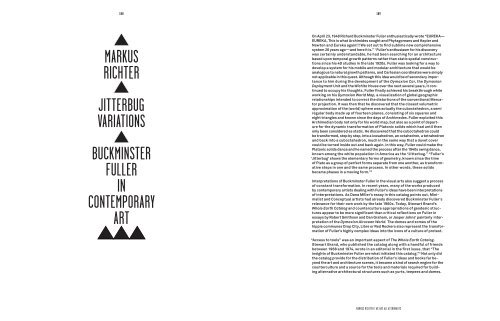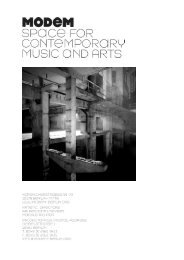MARKUS RICHTER JITTERBUG vARIATIONEN BUCKMINSTER ...
MARKUS RICHTER JITTERBUG vARIATIONEN BUCKMINSTER ...
MARKUS RICHTER JITTERBUG vARIATIONEN BUCKMINSTER ...
Erfolgreiche ePaper selbst erstellen
Machen Sie aus Ihren PDF Publikationen ein blätterbares Flipbook mit unserer einzigartigen Google optimierten e-Paper Software.
108 109<br />
markus<br />
richter<br />
JitterBug<br />
variations<br />
Buckminster<br />
Fuller<br />
in<br />
contemporary<br />
art<br />
On April 23, 1948 Richard Buckminster Fuller enthusiastically wrote “EUREKA—<br />
EUREKA, This is what Archimides sought and Phytagoreans and Kepler and<br />
Newton and Eureka again!!! We set out to find sublime new comprehensive<br />
system 20 years ago—and here it is.” 1 Fuller’s enthusiasm for his discovery<br />
was certainly understandable, he had been searching for an architecture<br />
based upon temporal growth patterns rather than static spatial constructions<br />
since his 4D studies in the late 1920s. Fuller was looking for a way to<br />
develop a system for his mobile and modular architecture that would be<br />
analogous to natural growth patterns, and Cartesian coordinates were simply<br />
not applicable in this quest. Although this idea would be of secondary importance<br />
to him during the development of the Dymaxion Car, the Dymaxion<br />
Deployment Unit and the Wichita House over the next several years, it continued<br />
to occupy his thoughts. Fuller finally achieved his breakthrough while<br />
working on his Dymaxion World Map, a visualization of global geographic<br />
relationships intended to correct the distortions of the conventional Mercator<br />
projection. It was then that he discovered that the closest volumetric<br />
approximation of the (world) sphere was actually the cuboctahedron, a semi<br />
regular body made up of fourteen planes, consisting of six squares and<br />
eight triangles and known since the days of Archimedes. Fuller exploited this<br />
Archimedian body not only for his world map, but also as a point of depart-<br />
ure for the dynamic transformation of Platonic solids which had until then<br />
only been considered as static. He discovered that the cuboctahedron could<br />
be transformed, step by step, into a icosahedron, an octahedron, a tetrahedron<br />
and back into a cuboctahedron, much in the same way that a duvet cover<br />
could be turned inside out and back again. In this way, Fuller could make the<br />
Platonic solids dance and he named the process after the 1940s swing dance,<br />
known among the white population in America as the “Jitterbug.” “Fuller’s<br />
‘Jitterbug’ shows the elementary forms of geometry, known since the time<br />
of Plato as a group of perfect forms separate from one another, as transformative<br />
steps in one and the same process. In other words, these solids<br />
became phases in a moving form.” 2<br />
Interpretations of Buckminster Fuller in the visual arts also suggest a process<br />
of constant transformation. In recent years, many of the works produced<br />
by contemporary artists dealing with Fuller’s ideas have been interpretations<br />
of interpretations. As Dana Miller’s essay in this catalog points out, Minimalist<br />
and Conceptual artists had already discovered Buckminster Fuller‘s<br />
relevance for their own work by the late 1960s. Today, Stewart Brand’s<br />
Whole Earth Catalog and counterculture appropriations of geodesic structures<br />
appear to be more significant than critical reflections on Fuller in<br />
essays by Robert Smithson and Dan Graham, or Jasper Johns’ painterly inter-<br />
pretation of the Dymaxion Airocean World. The domes and zomes of the<br />
hippie communes Drop City, Libre or Red Rockers also represent the transformation<br />
of Fuller’s highly complex ideas into the icons of a culture of protest.<br />
“Access to tools” was an important aspect of The Whole Earth Catalog.<br />
Stewart Brand, who published the catalog along with a handful of friends<br />
between 1968 and 1974, wrote in an editorial in the first issue, that “The<br />
insights of Buckminster Fuller are what initiated this catalog.” 3 Not only did<br />
the catalog provide for the distribution of Fuller’s ideas and books far be-<br />
yond the art and architecture scenes, it became a kind of search engine for the<br />
counterculture and a source for the tools and materials required for build-<br />
ing alternative architectural structures such as yurts, teepees and domes.<br />
markus richter / We are all astronauts





